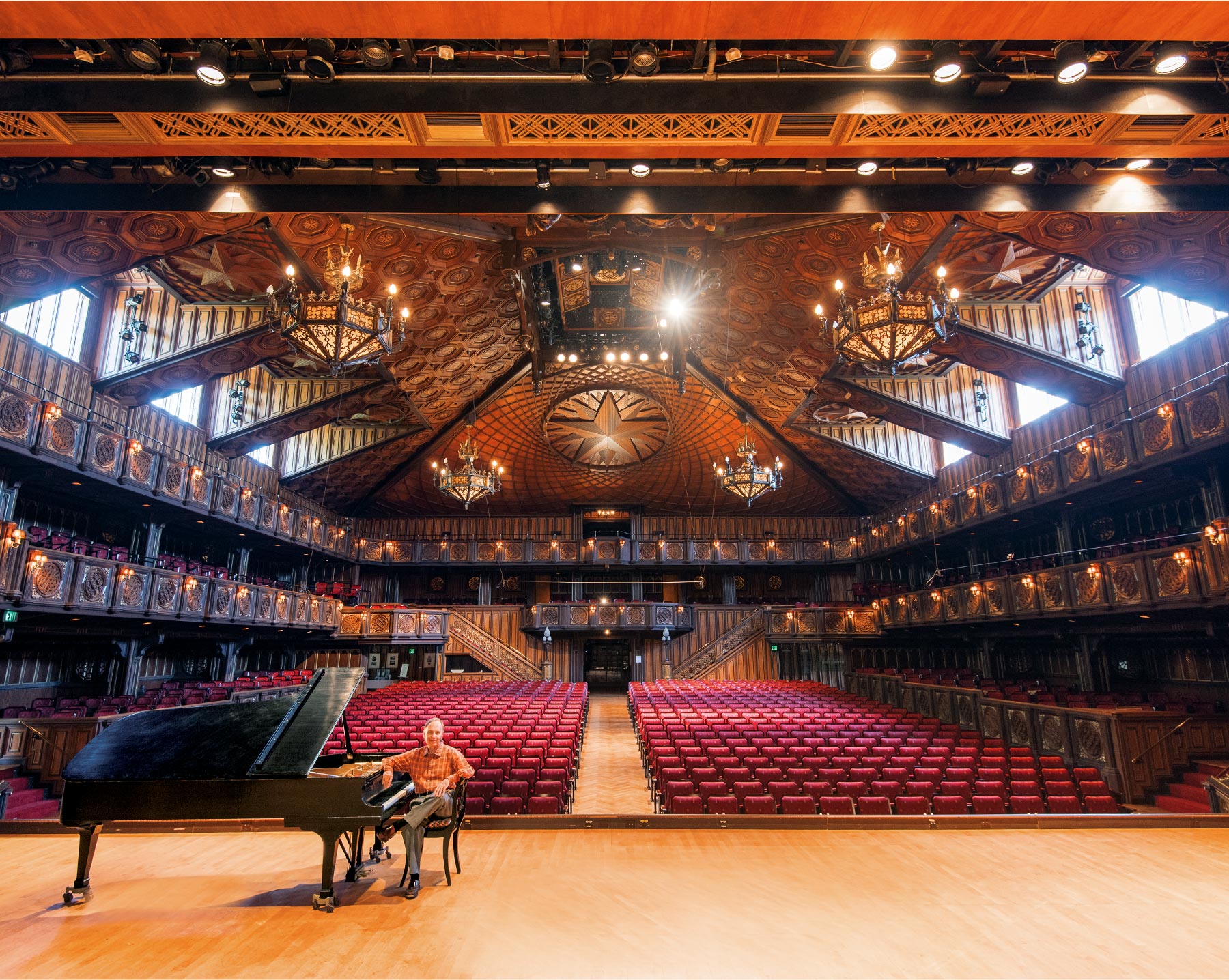On a hot July evening in Round Top, more than 600 people, almost seven times the population of the town itself, file into a majestic concert hall that looks more like it belongs in an old European city than here in the Hill Country. They come dressed for this occasion in high style—bejeweled jeans, navy blazers, flowy black dresses layered with gold jewelry, and, of course, a few Stetson cowboy hats. One usher sports a sparkling teal ball gown.
It is the closing concert of the Round Top Music Festival, a six-week-long intensive institute where nearly 100 high-level music students from across the world spend a summer, tuition-free, studying classical music and performing more than 30 concerts. Tonight, as is tradition for the final concert, the internationally renowned pianist James Dick will join his students on stage.
I’m sitting with Jack and Ruth Elvig, BSN ’77, Life Member, who live just five miles away, on a farm they moved to from Houston nine years ago. Jack is my unofficial tour guide for the weekend. His business card tells you much of what you need to know about him. On one side, in white lettering over a faded photo of green grass, it reads “Jack Elvig. High Protein Hay.” On the other side, on top of a glamour shot of the very concert hall we are sitting in: “Docent. Festival Hill.”
“We don’t like to miss it when James plays,” the 84-year-old retired-hay-farmer-turned-classical-music-enthusiast whispers excitedly as the lights dim. “You can see the music go right through him.”
Dick, 77, in a cream-colored sports jacket, walks onstage and gives the audience a quick wave. Jack, Ruth, and the other locals sitting around them (who include the county judge and the Elvigs’ preacher and his wife) applaud wildly.



To them, this is not just a Texas Medal of Arts recipient here to play for them world-class music. Without James Dick, none of this would exist. It is his vision that built it, and his energy that sustains it.
The institute and its sprawling campus came together over time, organically and magically. In the beginning, Dick didn’t have a clear picture of all that Festival Hill would become. “But maybe I had a dream,” he tells me. “And you don’t always know what your dreams are.”
Dick, BM ’63, Life Member, Distinguished Alumnus, was raised on a farm in Kansas. When it was time for him to start public school, his parents decided to move into nearby Hutchinson, where his father, George, became an auto mechanic and Dick became known for his musical prowess. “Jimmy loves to play the percussion instruments,” his kindergarten teacher wrote to his parents. But instead of drums, for $75, they bought an old, upright piano for their only child a month before his sixth birthday. “A beautiful sounding instrument,” Dick remembers. It’s impossible for Dick to mention an instrument without taking a detour to praise the way it plays.
His piano playing became a family affair. He and his mother, Dorothy, would play duets together or he would accompany his father, who loved to sing. “Daddy would come home, he was very tired at night, but he would lie down on the sofa and never object to my practicing,” Dick remembers. “And I think now that probably meant a lot to me, that they showed that kind of interest.” He often had an audience: Neighborhood kids would sit up on his porch while Dick practiced. “That probably had some influence, too,” he says. “Who knows?”
Like the paths of many artists, Dick’s musical success is a combination of talent, hard work, and serendipity. Dick’s childhood piano teacher, Leota Anderson, grew up with the family of renowned pianist Dalies Frantz, who was teaching at The University of Texas. When Dick was a junior in high school, Anderson drove him down to Austin to meet Frantz, who had just suffered two heart attacks. “He was still in a robe and pajamas. He had gotten out of bed just to hear me,” remembers Dick, who decided to attend UT shortly after the trip. Frantz was one of the first in a long line of people to be overcome by Dick’s ability.
After graduating from UT in 1963, and spending two Fulbright Fellowships at the Royal Academy of Music in London, Dick was beginning his concert career in full, picking up international music awards along the way. His summers, though, were open—a time meant to give musicians a break in their travel and allow them to learn new repertoire. “But I’d always loved to teach,” Dick says, “I thought maybe there will be someplace we can find where we can invite some pianists to come.”
Meanwhile, Texas arts patron Ima Hogg, 1901, Distinguished Alumna, a good friend of Frantz, was becoming a big fan of Dick, coming into Austin to hear him play whenever he was in town. One day, over lunch with Hogg and Frantz, Dick shared his dream of teaching in the summers. “Have you ever heard of Round Top?” Hogg asked.
Dick visited soon after. Round Top, where Hogg had a home, was founded in 1826 by German and English immigrants and had long been a haven for artists. The town, 80 miles east of Austin, was once a home for musicians and poets like Clara Rummel, known in the 19th century as the “poetess of Texas.” In 1970, when Dick visited for the first time, the 640 acre-town was undergoing a renaissance. It had just begun its Antiques Week tradition (an event that these days draws nearly 150,000 antique enthusiasts to the area twice a year) and philanthropists Charles and Faith Bybee were busy transporting buildings from nearby towns to the town square and giving them facelifts.
Dick, a lover of architecture, was intrigued. He started talking to some residents. Would they be interested in letting him put a piano in their homes? They needed one house per student. “We got enough people to say yes,” Dick says with a hint of surprise, even all these years later. “Even Ima, she said, ‘Sure, put a piano in my place.’”
A year later, the first institute was held. A 10-day session, it featured 10 piano students and two concerts in the old courthouse building in Round Top. By 1974, Dick had bought six acres of what was then a city dump, and the festival and its year-round operations moved into their permanent home at Festival Hill.
Jack and Dick both remember some mild resistance. Residents were more interested in country music, or a dance hall like the one in Gruene. “I would call it a lack of appreciation,” Jack says. “They didn’t understand the music.”
In the mid ’70s, concerts were held on the porch of the first building Dick had moved to the property. Jack and Ruth used to dress their youngest daughters up and bring food for a picnic while they sat and listened to chamber music. “I don’t want to call it elegant,” Jack remembers, “sitting on a blanket with little girls in long skirts … but it was semi-elegant.” The music wasn’t too bad, either. They saw Yo-Yo Ma perform—“before he was Yo-Yo Ma,” Jack says—at one of those concerts.
In the early years of the institute, Dick was traveling the world, playing concerts and continuing to build his career. He picked up accolades as a top winner in the Tchaikovsky, Busoni, and Leventritt international competitions and served on the juries of the International Tchaikovsky Competition in Moscow and the Van Cliburn International Piano Competition in Fort Worth. But his thoughts were never far from Round Top.


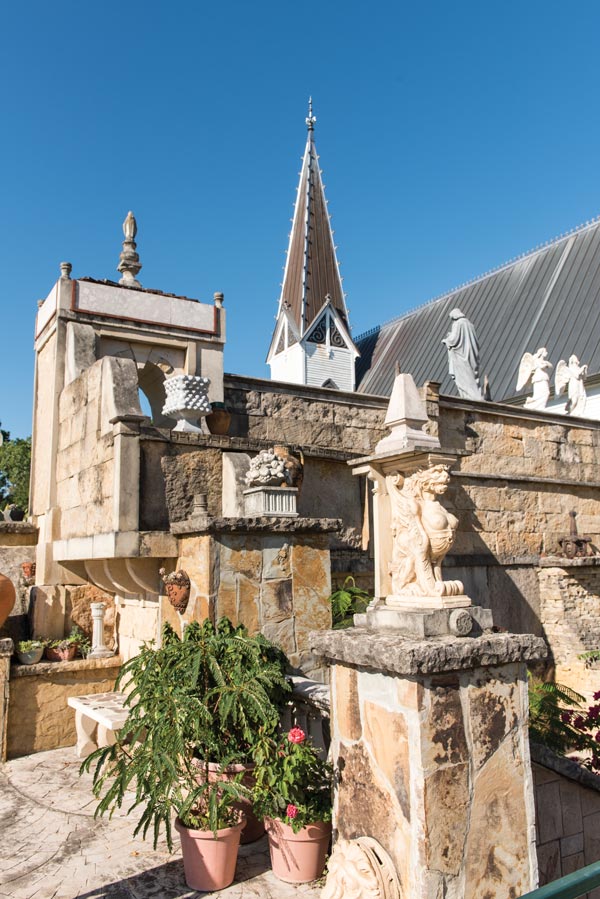
Now in its 47th year, the institute has a global reputation, and hosts more than 50 total year-round events, including an August-to-April Concert Series and an Herbal Forum. But the primary focus remains on the students, who come from conservatories and universities around the world with dreams of becoming professional musicians. Around 600 hopefuls apply each year to live on full scholarship for the summer, training with Dick and other talented faculty nearly all day, every day. There are private lessons, chamber music rehearsals, and small group rehearsals by instrument. Each week, a different real-world conductor arrives at Festival Hill to work with the students on a brand-new piece that they will learn and perform by the Saturday evening concert. The switching of conductors is intentional: It’s meant to prepare students for the unique demands and various personality types they might encounter in their professional lives. Festival Hill has graduated nearly 2,500 students—Dick says they have alumni teaching, performing, and employed as musicians on six continents.
“You know, we have some stones around here that have wonderful sayings on them,” Dick says, reciting one that features the Carl Sandburg quote, “Nothing happens unless first a dream,” before trailing off. “It’s hard to know how things are generated. But as a boy I always had a few pupils. And I had such wonderful training myself. [My teachers] gave back. I thought that was a very important matter to do. To give back.”
On one tour around the campus, Jack points out another inscribed stone. “Cur Cotidiana Somnies” it reads in Latin. Or, in English, “Why dream the ordinary?” Jack calls it Dick’s “logo,” which might seem trite except for the fact that Festival Hill is so far from ordinary.
To begin with, the architecture is a hodgepodge of old-world European meets Gothic revival meets Texas Hill Country. Dick kept the long, one-story yellow schoolhouse that came with the property—the first black school in Fayette County—in honor of Urissa Rhone Brown, its former principal. “I found out that she was a real wonderful educator,” he explains.
Several of the large buildings have been picked up and moved from somewhere else, and then carefully added onto, like the William Lockhart Clayton House. Originally built in 1885 in La Grange, it looks like a Victorian farmhouse, with light blue and yellow trim. Its long wooden wrap-around porch (now overflowing with palms and ferns) is where those first concerts were held. The Menke House, built in Hempstead in 1902, features dark wood and Gothic revival ceilings and woodwork. There is also, strangely, a log cabin at Festival Hill, donated by the family of a wealthy woman who admired Dick’s piano playing so much that when she died, her son and grandson wanted to give Festival Hill a piano in her honor. “They thought, ‘Well, there needs to be a place for a piano’,” Jack says. Their solution: Donate an entire log cabin, cut in place and built onsite.
Somehow, none of the buildings look out of place, although it can feel a little like Alice in Wonderland at times, wandering into, for instance, the stone basement that was built underneath the historic sanctuary of the former Travis Street United Methodist Church of La Grange, built in 1883. (If you ever find yourself at a Festival Hill party and are in search of a rocking guitar trio, head to the basement of the chapel.)
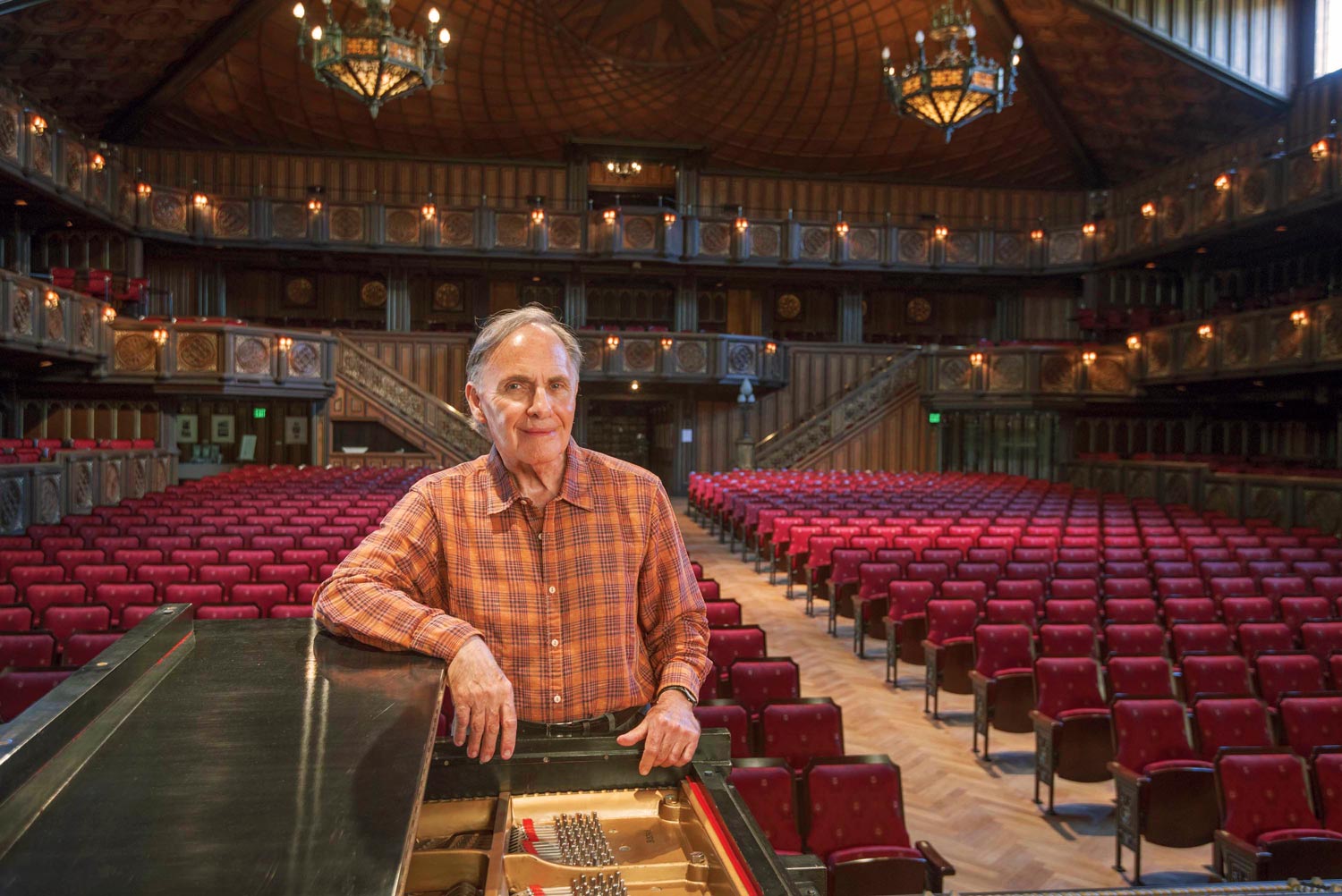
Meanwhile, the original six acres that Dick bought have slowly grown into over 200 verdant acres. There are fountains, gurgling creeks, and waterfalls. The lush, rolling grounds, can, like the architecture, be disorienting; I have never seen so much greenery in bloom during a Central Texas summer.
Dick says one of the things he was told when he first started the institute was that a Texas landscape could never compete with the prestigious East Coast festivals—he didn’t have the mountains, the sea, or the “green, lovely lawns.” Since then, and perhaps in spite of that, Dick says he has planted more than 24,000 trees.
Nearly half of the 12 full-time staff members (including Dick) live on campus and eat most of their lunches together in the lower level of the Menke House. Lamar Lentz, BA, BFA, ’73, MA ’91, is the associate managing director and library and museum collections curator. He came to Festival Hill in 1973 after working both as a special assistant for Harry Ransom and directly with Lady Bird Johnson as the registrar at the LBJ Library. “Jimmy always shared my belief that all great institutions had wonderful libraries,” Lentz explains. That has been exactly what Lentz was tasked with doing from the start.
Currently, he’s working on completing a comprehensive library backstage of the concert hall that will make Festival Hill’s extensive collection of rare books on music, musical archives, and Texas history accessible to the public through a book elevator and a sunny, cozy reading room. It will live next door to a gallery that will highlight rotating pieces from Festival Hill’s many permanent collections.
Lentz puts Festival Hill to me this way: “It’s like a great country house. There’s historical properties, historic collections, libraries, gardens. It functions as an educational concept that incorporates everything around it and what it has.”
There’s a living, breathing history to the buildings at Festival Hill, but everything within those buildings—artifacts that fill up walls and floors—have stories of their own, too. Russian nesting dolls from Dick’s trips abroad sit on shelves, and red vintage bricks from the old Austin Seton hospital line pathways. Some of these things, like the bricks, have been purchased. But the vast majority have been given to Festival Hill over the years.
I ask Jack about a particularly beautiful piece of stained glass in the Menke House. The glass, he explains with delight, is antique. Somebody sent it. “Things like this are always happening at Festival Hill,” he says. “People find stuff and send it to Festival Hill saying, ‘They’ll find a way to use it.’”
In a dark backstage area of the concert hall, Lentz runs two small museums. One features the archives and collections of Texas composer David Guion, including originals by pastel painter Frank Reaugh. The other room is the family collection of Anders Gustav Frederik Oxehufwud and his wife, a Swedish family who immigrated to America and found themselves in Round Top, attending concerts at Festival Hill. Their estate—which they left entirely to Festival Hill—includes an intricately carved wooden cabinet from 1635. It’s the kind of thing you might see in the Smithsonian.
And then, of course, is the pièce de résistance: A grand, 1,000-seat concert hall with a steepled ceiling. The hall is both majestic and intimate, with dark wood and soft lighting. When the music starts, it surrounds you.

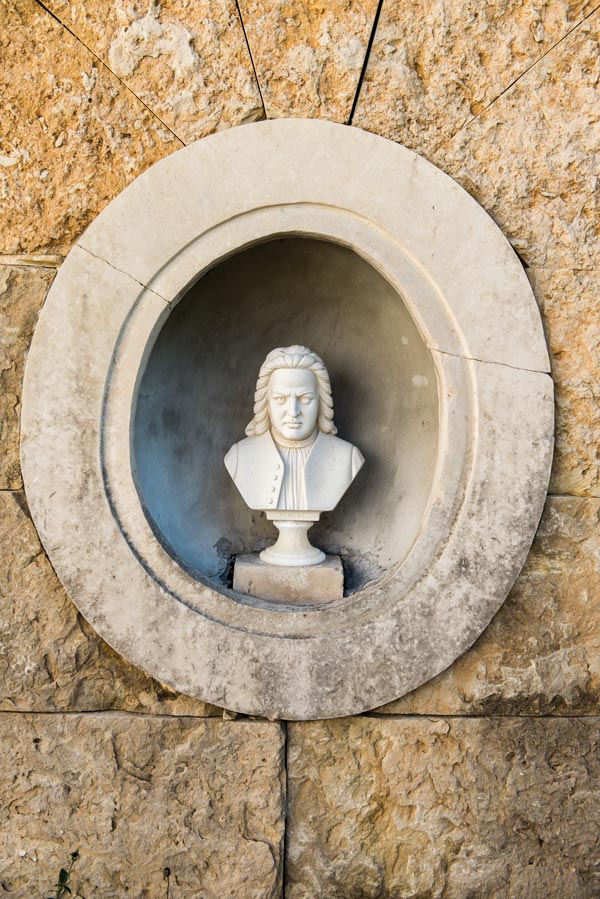

Construction on the hall began in 1981, though the concert hall wasn’t complete until 2012, which isn’t atypical for projects at Festival Hill. Dick tells me that “of course!” there will be a point where the campus feels finished, but first they need an ensemble room, which he’s hoping to have completed by Festival Hill’s 50th anniversary in 2020. As for Festival Hill’s 100th anniversary? “Number one,” Dick tells me. “It will still be here.” There’s a succession committee that Dick feels confident in, full of knowledgeable people in the arts—conductors, musicians, and patrons.
Part of the reason for the concert hall’s 31-year construction process is that Dick refuses to overspend—he estimates the total cost of constructing and building the concert hall to be around 12 million. Nearly 80 percent of Festival Hill’s operating budget comes from donations from foundations and individuals. Each year, Dick first puts aside the money needed to keep Festival Hill running and the doors open. Whatever is left is part of the capital budget and goes towards projects like concert hall construction.
The other reason is that Dick is a perfectionist. Instead of using acousticians, Dick and his team built the hall little by little, as they could afford. They stopped often to listen to music in it. Dick was never worried about the DIY-process or how the acoustics might turn out. He says matter-of-factly, “I knew we had good ears.”
Richard Boner, BS ’68, Life Member, is the vice president of BAi, an Austin-based acoustics consulting company, and a longtime patron of Festival Hill. He would have lunch every so often with Dick and Festival Hill Managing Director Richard Royall, LLB ’67, while they were constructing the hall.
At the first lunch, Dick brought out a piece of paper and sketched two shapes. “If we build a concert hall here,” Dick asked him, “which shape is better?” Each time they met was like this. “They knew what they wanted to do,” he tells me. “They just wanted to make sure it would work.”
Their most inspired idea came from a piece of tableware—an old Fostoria Company dessert plate from the David Guion collection. Dick shows it to me one afternoon—a circular piece of vintage glass with raised scallops that swirl toward the center. “I thought, my gosh, that might be an interesting ceiling,” he says. “So we started using just a compass with chalk and we sort of did it on the ceiling. And then, went from there.”
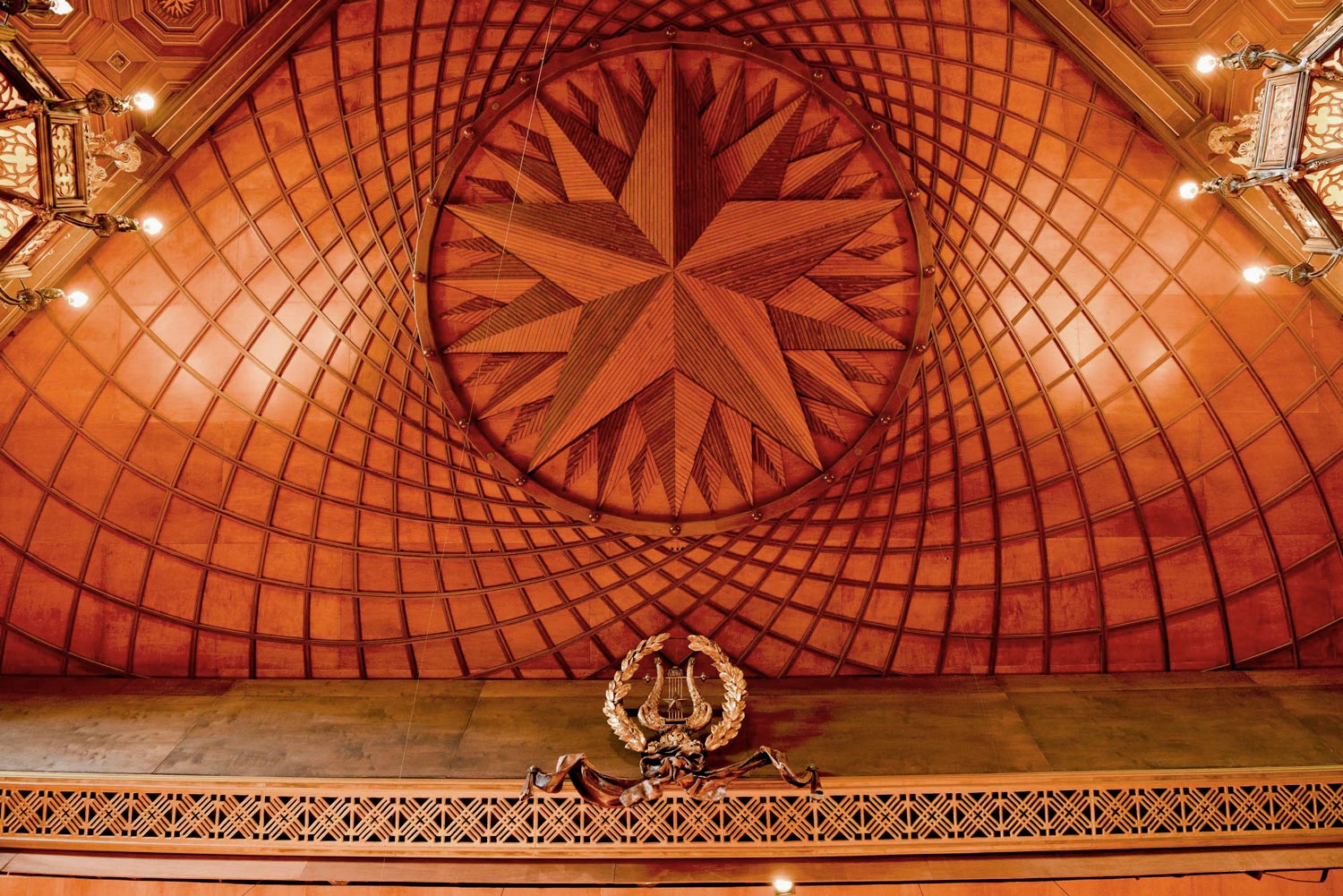
“From there” meant, among other things, lining the balconies with hundreds of hand-carved wooden medallions. There’s an 18-foot attic above the ceiling, allowing sound to travel up and reverberate, “so you’re sitting in a giant instrument,” Dick says. The visual result is stunning, but the intricate woodwork—headed by Larry Birkelbach, Festival Hill’s longtime carpenter—serves much more than an aesthetic purpose. The uneven wood surfaces, explains Boner, “is why it’s such a fine place to listen to music.”
The AC system is virtually silent, a complex and expensive process that is common for first-rate facilities. “But to find it in Round Top is gratifying,” Boner says. “It’s just another indication that this was always envisioned to be a first-class concert facility for the performing arts. That was [Dick’s] dream and he was able to achieve it mostly through his perseverance and vision.” Boner pauses before he adds, almost as an aside, “I just enjoy the heck out of the place, I really do.”
On the afternoon before the final concert of the summer, the dining room of the Menke House is full of chatty students. They have spent the past six weeks in intensive rehearsals, enjoying the grounds, finding friends and sometimes romance. Tonight’s final concert will be bittersweet. Tomorrow morning they will take off on buses headed to Austin’s airport but today, they are trying to soak in their final day in Round Top. After lunch, the majority of them will mosey over, as they do most days, to Espressions Coffee in town to play board games and get their daily free cup of coffee, a collective gift from Round Top residents.
I ask Dick about his own immense generosity. In addition to hosting the institute, Festival Hill hosts local ballerinas for The Nutcracker and elementary school children learn to swim at Festival Hill’s pool. Every May, the graduating seniors of Round Top-Carmine High School (all 20 or so of them) walk across the magnificent stage of the concert hall while Dick plays “Pomp and Circumstance” on his grand piano.
A few years ago, a group of preschool students were touring Festival Hill. Dick ran to the kitchen and came back with a grapefruit. He had each student sit at his grand piano in the concert hall and roll a grapefruit over the keys, while he sat at the other end of the piano bench and played an unconventional duet.
He explains this kindness with another one of his favorite sayings: “Grow where you’re planted. It means grow with help, and also grow with demand and your own sense of moving ahead.”
To Dick, growing in Round Top means helping the town grow, too. Since the institute began, Round Top public schools have started their own music program. It’s small, but it’s progress. They have a music teacher, a band, and a band director. “I can’t say we were totally the reason,” he says. “But I don’t think it would have been without us, quite frankly.”
When Dick plays the piano, his hands look like they belong to a puppet, moving not of their own volition, up and down the length of the instrument. With each crescendo his chest stays still, but his head shakes slightly—it’s as if he can’t quite keep his body from being swept up in the music. His mind is both there onstage, and somewhere else. You need to be present to know what you are doing, Dick tells me. “But you do have to let your mind soar.”
At the final concert that hot evening in July, Dick plays Chopin’s “Piano Concerto No. 1 in E minor (Op. 11)” with a chamber orchestra of his students behind him. At intermission, the hall is giddy. “There couldn’t have been another note coming out of that piano!” one woman practically yells.
Dick disagrees. The morning after, he’s up at 6:30 to practice the Chopin piece again. There were some things left to discover. “Practice to my mind is the wrong word,” he says. “I don’t know what to call it. But it’s just a joy. I learn so much because I’m curious. When I’m looking at the score, it’s not just black and white dots. It’s just a miracle. Every day I learn something.”
This story originally appeared in the November/December 2017 issue of the Alcalde.
